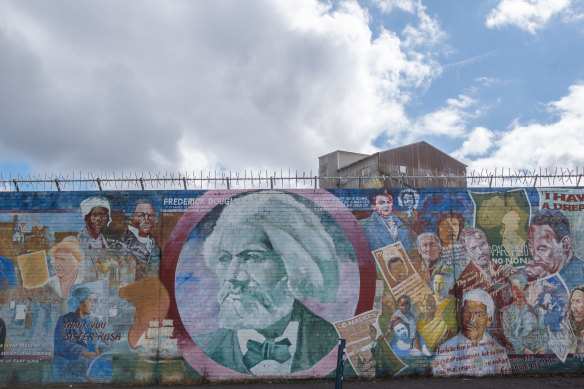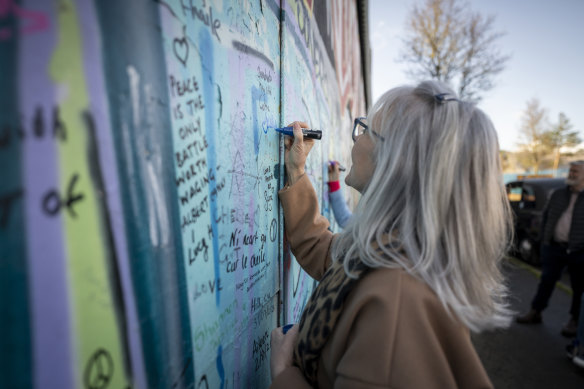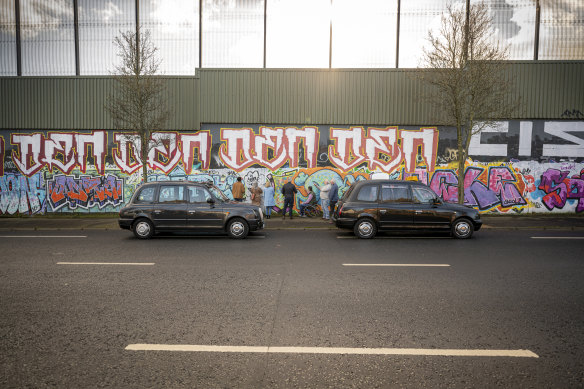The European city that’s still divided by a wall
I’m standing under a wall that is nothing quite like any wall I’ve seen before. This is a serious wall: stacked concrete slabs eight metres high, topped by barbed wire. Its surface is pockmarked by angry hammer dents and the burn marks of Molotov cocktails.

Street artists have taken to Belfast’s Peace Wall remains.Credit: Tourism Northern Ireland
The strangest thing about this wall is that it runs right through a seemingly ordinary residential neighbourhood. To outsiders such as those in our tour group, the redbrick houses on one side look no different to the redbrick houses on the other.
For the moment, the roads are open. Cars and public buses trundle through gaps in the wall, and pedestrians walk through at will. Yet come nightfall, giant gates seal off these two neighbourhoods in an uneasy night.
Some might say this is a dispiriting tourist experience – or not a tourist experience at all. But I’m on a tour of Ireland and Northern Ireland with Collette, a company keen on exploring the nuances of its destinations, rather than trotting out tourist cliches.
Today we’re in Belfast, and later we’ll have the opportunity to visit the excellent Titanic exhibition and spend some downtime wandering around the unexpectedly fine city centre. For now, local guides in black taxis are taking us on a tour of the Peace Walls, or what remains of them.

The walls once separated Protestant loyalist and Catholic nationalist enclaves during The Troubles.Credit: iStock
The walls separated predominantly Protestant loyalist and Catholic nationalist enclaves throughout what are euphemistically called The Troubles: three decades of bombings, murders, riots and civil-rights protests.
The tour proves to be a fascinating account of Belfast’s past, told well, and even with occasional humour. “We’re the nicest people in the world – but just not to each other,” jokes tour guide Tom Hanna, who grew up under the shadow of these barriers.

A visitor signs the Peace Wall.Credit: Tourism Northern Ireland
The walls were first erected in 1969 by the British army to curb riots. They were temporary affairs of corrugated iron, but soon extended and upgraded to bricks, steel and concrete. Though not all linked, 38 kilometres of walls still slice through the city. They’ve stood for longer than the Berlin Wall.
Our tour takes us to the Shankill and Falls roads area of western Belfast, which were particularly notorious during The Troubles. The wall here is splattered with political messaging, which makes it easy to know what side we’re on.
One side has portraits of British soldiers and the queen. Kerbs are painted red, white and blue. On the other the colours of the Irish flag predominate, framing portraits of Republican heroes and hunger-strike martyrs.

The dividing line.Credit: Tourism Northern Ireland
“We did a Donald and built a wall to keep people apart,” says Hanna. He explains that the walls were supposed to come down in 2023 on the 25th anniversary of the Good Friday agreement that ended Northern Ireland’s factional wars.
Only some short sections have been removed. Partly they’ve become a tourist attraction, while the communities that live closest to them say they still provide a sense of security. “People are easily divided. It’s much harder to bring them together again,” Hanna says.
Our guides are optimistic for the future, though. Younger generations have no experience of The Troubles, prejudice has declined, tensions have faded, people can see life is much better, says Hanna.
The murals painted on the walls have become less aggressive. Many have moved on to comment on other causes: Ukraine, Palestine, Black Lives Matter. As we continue onwards, the highest, grimmest section of wall is scribbled only with the comments and signatures of visitors, and their hopes for continued peace.
The details
Tour
Collette’s 14-day The Best of Ireland tour between Dublin and Kilkenny spends two nights in Belfast, including a tour of the Peace Wall, and visits several other destinations such as Donegal, Enniskillen, Galway and Dingle. The next departures are between March and May, 2025. From $6199 a person including twin share accommodation, transport, select meals and tour guides.
Collette has other tours in Ireland, among them is the 12-day Shades of Ireland that spends three nights in Belfast and visits other destinations such as Waterford, Killarney, Enniskillen and Derry. See gocollette.com
More
visitbelfast.com
The writer travelled as a guest of Collette.
Sign up for the Traveller Deals newsletter
Get exclusive travel deals delivered straight to your inbox. Sign up now.